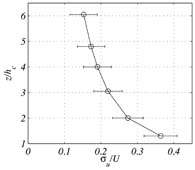A Description of the Main Flow Features
 Forested areas often have considerable potential wind power available, and because they are sparsely populated they have the advantage that there are fewer people to object to any wind turbines. Also, these onshore sites are convenient because of the low maintenance costs when compared to offshore wind farms. However, it is generally recognised that the wind flow over a forest will be highly turbulent, leading to more severe fatigue loads on the wind turbine blades than those encountered on other flatter, more homogeneous sites. This article attempts to provide a description of the main characteristic wind flow features in forested areas, together with an overview of the current methods being used to evaluate the quality of a given forest site.
Forested areas often have considerable potential wind power available, and because they are sparsely populated they have the advantage that there are fewer people to object to any wind turbines. Also, these onshore sites are convenient because of the low maintenance costs when compared to offshore wind farms. However, it is generally recognised that the wind flow over a forest will be highly turbulent, leading to more severe fatigue loads on the wind turbine blades than those encountered on other flatter, more homogeneous sites. This article attempts to provide a description of the main characteristic wind flow features in forested areas, together with an overview of the current methods being used to evaluate the quality of a given forest site.
By Antonio Segalini, the Linné FLOW Centre of the Royal Institute of Technology (KTH), Sweden
 Forested areas often have considerable potential wind power available, and because they are sparsely populated they have the advantage that there are fewer people to object to any wind turbines. Also, these onshore sites are convenient because of the low maintenance costs when compared to offshore wind farms. However, it is generally recognised that the wind flow over a forest will be highly turbulent, leading to more severe fatigue loads on the wind turbine blades than those encountered on other flatter, more homogeneous sites. This article attempts to provide a description of the main characteristic wind flow features in forested areas, together with an overview of the current methods being used to evaluate the quality of a given forest site.
Forested areas often have considerable potential wind power available, and because they are sparsely populated they have the advantage that there are fewer people to object to any wind turbines. Also, these onshore sites are convenient because of the low maintenance costs when compared to offshore wind farms. However, it is generally recognised that the wind flow over a forest will be highly turbulent, leading to more severe fatigue loads on the wind turbine blades than those encountered on other flatter, more homogeneous sites. This article attempts to provide a description of the main characteristic wind flow features in forested areas, together with an overview of the current methods being used to evaluate the quality of a given forest site.By Antonio Segalini, the Linné FLOW Centre of the Royal Institute of Technology (KTH), Sweden








